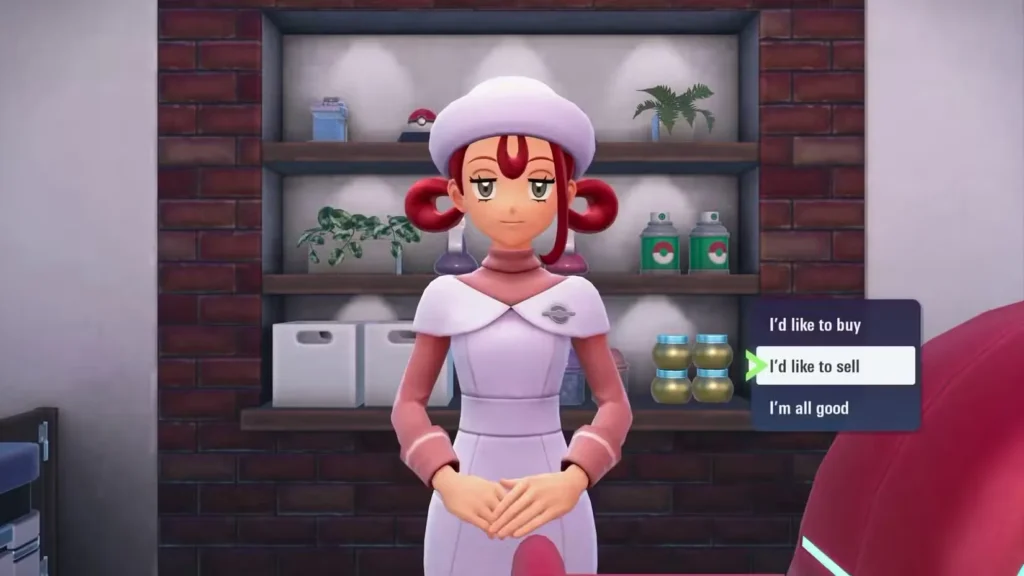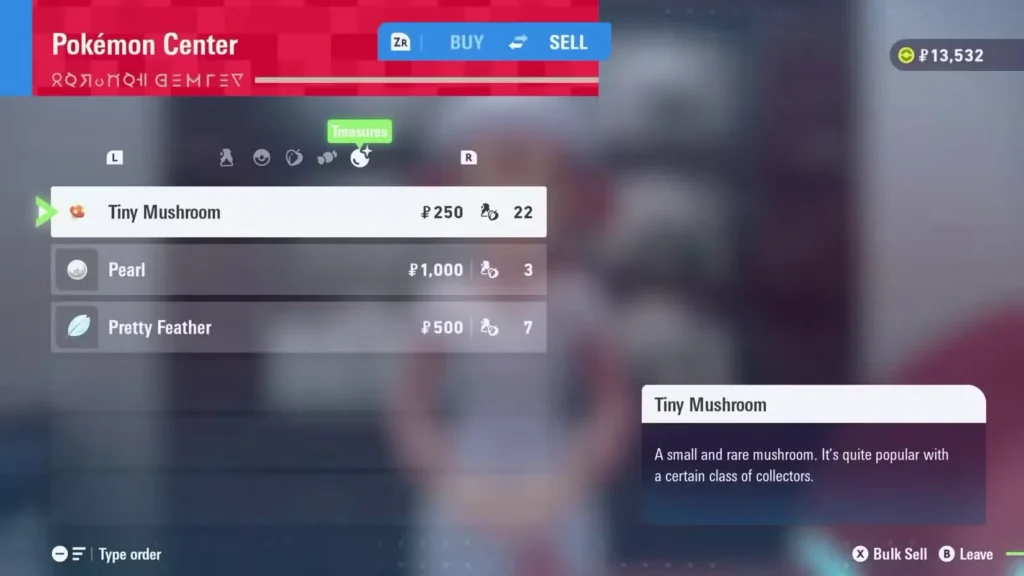
Newsletter Subscribe
Enter your email address below and subscribe to our newsletter

Enter your email address below and subscribe to our newsletter
Your Source for Game News and Guides

Learn what Tiny Mushrooms are used for in Pokemon Legends Z-A, how to sell them for money, and which treasure items are worth collecting for maximum profit.
If you’ve been exploring Lumiose City in Pokemon Legends Z-A, you’ve probably noticed those tempting gold sparkles scattered everywhere. Walk over one, and you get an item. Walk over ten more, and suddenly your inventory is overflowing with something called “Tiny Mushrooms.”
At first, you might think these are crafting materials or consumables for your Pokemon. Maybe they boost stats? Help with evolution? Nope. You can’t use them on Pokemon, you can’t combine them into anything useful, and there’s no cooking system in the game to turn them into meals.
So what’s the point? Why is the game showering you with these things? Let me clear up the confusion and show you exactly what to do with Tiny Mushrooms—and why you should actually be excited every time you find one.
Tiny Mushrooms exist for one purpose: to be sold for cash. Each one is worth ₽250 at any Pokemon Center.
I know what you’re thinking—₽250 doesn’t sound like much. And you’re right, individually they’re not impressive. But here’s the thing: Tiny Mushrooms are everywhere. After a few hours of gameplay, you’ll have dozens of them cluttering your inventory. That’s when you realize you’ve been sitting on thousands of Poke dollars without even trying.
Think of Tiny Mushrooms as the game’s way of passively rewarding exploration. Every time you walk off the main path to grab those sparkles, you’re banking money for later. It adds up faster than you’d expect.

If you’re new to Pokemon Legends Z-A, the selling interface might not be immediately obvious. Here’s exactly how to turn those mushrooms into money:
Open your Satchel and navigate to the Treasures section. This is where all sellable items live—Tiny Mushrooms, Pearls, Pretty Feathers, and anything else marked as a treasure.
You’ll see exactly how many Tiny Mushrooms you’ve accumulated. Don’t be surprised if the number is higher than you expected.
Pokemon Centers are scattered throughout Lumiose City. Find the nearest one—they’re marked on your map and impossible to miss with their distinctive red roofs.
Interact with the Pokemon Center nurse at the counter.
Choose “I’d like to do some shopping” from the menu.
Select “I’d like to sell” from the shopping menu.
Navigate to your Tiny Mushrooms in the treasure inventory and select how many you want to sell. You can sell them individually or in bulk—I recommend bulk selling unless you have a specific reason to keep some.
Confirm the sale and watch your money total increase. That ₽250 per mushroom starts looking better when you’re selling 20+ at once.
Pokemon Legends Z-A makes treasure items pretty straightforward, which is actually a smart design choice. Here’s how the system works:
The game explicitly labels certain items as Treasures, which is code for “this has no use except to sell it.” It’s the game’s way of saying, “don’t worry about using this for something important—just cash it in.”
This is common in modern video games. Instead of having players hoard items wondering if they’ll need them later, the game tells you upfront: “this is money, treat it as money.”

Those gold sparkling patches on the ground are your treasure spawn points. Every time you see one, it’s guaranteed to give you something—and Tiny Mushrooms are the most common reward.
Pro tip: Make it a habit to walk over every gold sparkle you see. Even if you’re in a hurry to reach a specific destination, the two-second detour to grab sparkles pays off over time. Think of it like picking up loose change—individually small, collectively significant.
Tiny Mushrooms aren’t the only treasures in the game. As you explore, you’ll find several other sellable items:
Pearls: Sell for significantly more than Tiny Mushrooms. These are less common but worth grabbing whenever you spot them.
Pretty Feathers: Another valuable treasure item that commands a higher price than mushrooms.
Other treasures: Various items appear throughout the game, all marked in the Treasures section of your Satchel.
The general rule: if it’s in the Treasures section, sell it. There’s no hidden use case, no secret crafting recipe that requires them. They exist purely as currency conversion items.
Let me make the case for why you should care about these unassuming fungi:
Pokemon Legends Z-A has plenty of items worth buying:
All those Tiny Mushrooms you’ve been collecting? That’s your shopping budget right there.
Unlike grinding for money by repeatedly battling trainers, collecting treasures happens naturally as you explore. You’re not going out of your way or dedicating time specifically to money-making—you’re just playing the game normally and getting paid for it.
If you’re completing Wild Zone 2 or exploring other areas, those sparkles are everywhere. Grab them while you’re hunting Pokemon and you’re essentially multitasking.
Unlike other Pokemon games where your bag space might be limited, Tiny Mushrooms don’t really hurt you by accumulating. They stack nicely in your Treasures section and don’t interfere with important items.
You can safely collect hundreds of them without worrying about running out of space for actual useful items.
The beginning of Pokemon Legends Z-A can be surprisingly tight on money. You’re buying Poke Balls, restocking healing items, and trying to save for evolution stones. Having a stockpile of Tiny Mushrooms to sell gives you financial breathing room when you need it most.
By the time you’re trying to afford that Stone Emporium purchase on Vernal Avenue, you’ll be grateful for every mushroom you picked up.
Want to maximize your treasure collecting? Here are some strategies that work:
Certain areas of Lumiose City have more gold sparkles than others. As you explore, mentally note which districts have the most treasure spawns. When you need money quickly, revisit these areas.
Never make a trip solely for treasure collecting—that’s inefficient. Instead:
Gold sparkles appear in Wild Zones too, not just Lumiose City proper. When you’re exploring areas looking for Alpha Pokemon, keep an eye out for those golden glimmers.
This is personal preference, but I recommend selling your treasures every time you visit a Pokemon Center rather than letting them accumulate forever. Why?
That said, some players prefer hoarding treasures and doing one massive sell-off. Both approaches work.
If you see a Pearl or Pretty Feather sparkle versus a likely Tiny Mushroom sparkle, and you can only grab one before entering a battle or mission… prioritize the higher-value item. You’ll find plenty of mushrooms, but rarer treasures shouldn’t be skipped.
Nope. They have exactly one function: being sold for ₽250. Don’t waste time looking for hidden uses—they don’t exist.
No need. If a future update somehow adds a use for them (unlikely), you’ll find more easily enough. They’re too common to worry about running out.
Possibly! In older games, some treasures had different values. Pokemon Legends Z-A sets Tiny Mushrooms at ₽250, which is reasonable given how common they are.
Not as far as testing has shown. They’re currency items meant for selling to Pokemon Centers, not trading to NPCs.
Yes! Gold sparkles respawn over time, so you can revisit areas and find more treasures. The game wants you to have a steady income stream.
Now that you understand Tiny Mushrooms are essentially money, let’s talk about smart spending:
Your Tiny Mushroom collection funds all of this. Never underestimate passive income.
Here’s something interesting: treasure items like Tiny Mushrooms exist partly for psychological reasons.
Variable reward schedule: Every time you walk over a sparkle, you don’t know if you’ll get a common Tiny Mushroom or a valuable Pearl. This uncertainty makes collecting sparkles more engaging than if they gave you money directly.
Tangible accomplishment: Seeing “x30 Tiny Mushrooms” in your inventory feels like accumulated wealth. It’s more satisfying than just having numbers increase invisibly.
Player agency: You choose when to sell, giving you control over your finances. This feels better than auto-converting items to money.
Game designers know these tricks work, which is why treasure systems appear in countless games. Pokemon Legends Z-A just happens to use Tiny Mushrooms as its primary treasure currency.
Tiny Mushrooms connect to various game mechanics:
Exploration incentive: They reward you for thoroughly exploring Lumiose City and Wild Zones. If you’re trying to figure out if you can leave Lumiose City, know that exploration anywhere yields treasures.
Time management: Changing time from day to night might affect sparkle spawns. Some players report finding different treasures at different times, though this needs more testing.
Progression support: Early-game financial struggles are eased by treasure collecting, ensuring players can afford essential items even if they’re not great at battles yet.
Tiny Mushrooms might seem like vendor trash at first glance—and technically, that’s exactly what they are. But calling them “trash” misses the point. They’re a reliable, passive income source that funds your entire Pokemon journey.
Key takeaways:
The next time you spot that golden sparkle on the ground, don’t walk past it. That’s not just a Tiny Mushroom—that’s a few steps closer to buying that evolution stone, restocking your Poke Balls, or affording whatever else you need.
Now get out there and start collecting those sparkles. Your wallet will thank you!
For more Pokemon Legends Z-A guides and tips, visit the official Pokemon Legends website or grab the game from the Nintendo Store.